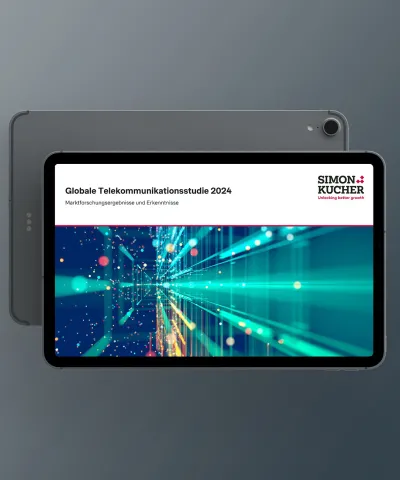In the coming years, telecommunications providers will face numerous challenges due to digitalization, accelerated by the COVID-19 pandemic. Here’s why up- and cross-selling, seamless omnichannel sales, sustainable tariff structures, and churn management will be key toward the end of the crisis and the years that follow.
The COVID-19 crisis has accelerated numerous digital trends in various industries. Stores have been forced to shift their sales activities into the digital sphere and in some markets the number of digital sales channels increased by more than 100 percent in just under three months. Working from home (or basically anywhere) as well as virtual collaboration tools have become increasingly common, telehealth solutions more widely available, and e-learning almost the norm. These trends put the importance of telecommunications services directly under the spotlight – an industry with just a 7 to15 percent digital sales pre-COVID-19.
So, are telco providers ready for accelerated digitalization and everything that comes with it?
Let’s answer this question with a short anecdote. Like the majority of office workers around the globe, in April 2020 I suddenly found myself working remotely. Thanks to modern technology, this adjustment was relatively simple. Yet with all family members in lockdown under one roof, activities like surfing the internet, streaming TV shows, and simultaneously taking important business calls quickly put a strain on my bandwidth.
Then, six months into the crisis, I realized my telecom provider had been offering one gigabyte of free data volume with my tariff. Although it could still be activated, I should have discovered this offer earlier. The only reason I looked into the app was because, as an advisor to the telecommunications industry, I was interested in my provider’s digital sales approach. As a consumer – there was zero engagement.
In contrast, one app I check every day is for the solar panels on my roof. It tells me how much energy is coming from the network, how much is going in or out of my storage, and how much energy I consume. This data doesn’t add any value to my life or influence my decisions. In fact, it is pretty useless. Yet I am checking it religiously. The little moving arrows and attractive display have sparked my curiosity and keep me engaged. (Meanwhile, I'm a telecommunications expert and I didn’t open my telco app for six months). The moral of this story? Telco providers need to do a better job of engaging their customers.
How can providers emerge stronger from this crisis through digitalization and enhanced customer engagement? Here are five recommendations:
Develop a digitally empowered ecosystem
My telco app experience is something most can relate to, largely because everyone has at least one SIM card. However, telcos don’t just sell mobile connectivity, but also many other things on top. Value-added services include broadband, mobile data cards, TV, and OTT TV. So why is the chip still sold as if it were the main product on a mobile phone, and apps just used as service zones?
To move away from service-oriented apps, inspiration can be drawn from the banking industry, where customers are traditionally used to relatively “boring” stand-alone products. Some banks, however, have managed to make their products fun. They apply behavioral science and goal setting theory on their digital sales platforms, e.g. by displaying their products and services in a “sticker album” or as a puzzle with missing pieces. Customers are encouraged to collect new “items” in exchange for benefits or special conditions. In our recent case study, we describe how a bank was able to attract 205 percent more app users and saw a 105 percent increase in credit card sales thanks to its gamified approach.
Telcos could apply these techniques to their wide range of communication and entertainment services. Apps could be transformed into sales platforms that enable a step change from push to pull sales and marketing for converged product portfolios – also possible in an omnichannel approach that spans across stores, call centers, and the website. “Next best offer” recommendations based on AI and ML algorithms enhance this approach even further and ensure a holistic customer experience.
Create and optimize digital go-to-market and omnichannel capabilities
The COVID-19 pandemic is driving digital sales channels and there is no way back. Omnichannel journeys are becoming the rule, where unified offer suggestions and knowledge about previous touchpoints will be key. However, as the importance of online channels and a seamless customer journey grows, most telco companies continue to operate their digital and physical channels independently.
In a recent discussion with a telco provider, my client reacted to a recent uptake in online sales. “We don't want this. We don't sell the same value online as we typically sell in our stores or on the phone with the customers.”
This captures how operators still don’t have the necessary digital and omnichannel capabilities to feel comfortable with customers shopping online. For customers, the provider’s fear translates into confusion. They visit a store for something pushed on the website but the sales agent gives a completely different recommendation, usually at a different price.
Instead, imagine a comprehensive data management system were supporting the agent in the store, providing them with information about what the customer has viewed online. What if the sales incentive scheme included omnichannel elements, with the customer’s browsing history used as a starting point for conversation? Digital touchpoints could be integrated in the store concept for customers who prefer to complete their purchases online, supported by smart AI-based engines to identify the best price and offer.
Use tariff structure 3.0 as a tool for market recovery
A few years ago, when talking with telco companies, I used to hear how additional data consumption would lead to increased revenues. I argued the opposite: competition would drive the data included in tariffs, leaving telco providers little room to monetize. This is exactly the outcome in almost all markets.
Fast forward to 2021 and the age of gigabyte- and data-volume-based price differentiation is coming to an end. Mobile data usage has increased 36 percent per year since 2016, while the average price per gigabyte in a tariff has declined by 28 percent per year. Telco operators have been increasing the data volume in their tariffs to prevent customers from going to the competition. This has deflated the gigabyte price, but has managed to keep the average revenue per user (APRU) stable – until now.
What comes next once data volume is unlimited? If providers introduce an unlimited data tariff without stopping the price decline, they will soon start to hit their ARPU If this happens, they’re in real trouble. What’s needed is a tariff structure 3.0.
The good news is that, if your market is still in a relatively high price situation today, you have the freedom to influence and shape the market standard of the future. You can be the first to differentiate and set up the new structure. Here key questions to answer are which services can differentiate future tariff portfolios? How can stronger differentiation from competition be achieved? And is there potential to stop the price decline in the market?
Drive excellence in customer base management
Although churn has decreased dramatically during this pandemic, the number of customers out of contract is growing. Our recent study shows that in fact, COVID-19 has increased the overall likelihood of churn by 15 percent, and this risk is further fueled be the recent implementation of the EECC into national law. Therefore effective customer base management is more necessary than ever.
Meanwhile, most operators are offering the lowest entry tariff price, or 50 percent off for the entire first contract period. However, this acquisition approach ultimately increases churn risk. At the end of the promotion, prices increase significantly, triggering customers to seek better offers. Sustainably reducing churn post-COVID-19 will be key, driving the need for proactive customer base management.
Clients often ask which group is commercially more interesting. Existing customers or new customers? The answer is that new customer growth is limited. The opportunity lies in growing existing customers. Not only is keeping them five times cheaper than acquiring new ones, the probability that they will try new products is 50 percent higher, and they contribute 95 percent share to the profit pool.
However, if you look at today’s telco activities, its new customers who get all the benefits: lower prices, more value, and more attention. Why should an existing customer remain loyal when in most cases they are punished?
![Telco Trends]()
Best-in-class companies are customer-centric, not just when a customer needs to be acquired or renewed, but as a lever to drive lifetime loyalty. They set up a digital ecosystem to use all the perks and the benefits of digitization while still focusing on the commercial approaches. Value-based pricing, loyalty programs, customized offers, smart discount schemes, and exclusive benefits ensure seamless coverage is provided across the entire customer lifecycle. In short, price promotions don’t necessarily have to lead to eventual churn, but telcos need to take action afterwards. They need to be smart, factor in the competition, and loyalize customers.
Most importantly, they need to be there for customers. In our recent service survey, 51 percent of respondents claimed that they are now more often at home and use the internet frequently, while 49 percent claimed that since they are now working from home they are in need of a stable connection.
The survey also found that one third of customers look for a new provider if issues are handled badly, with the number one trigger named as poor connectivity. On the other hand, when issues are promptly resolved, customers are more likely to remain loyal. Therefore, it's not about completely eradicating connectivity issues, but rather how you deal with them, which requires excellent service.
We asked respondents if they had changed their broadband internet provider since COVID-19? Why/why not? Here are the results:
![Results]()
Enrich the offer portfolio by adopting more flexible working models
With a large proportion of the workforce confined to their homes, there has never been a greater need for unified collaboration and communication applications. Many are looking to their employers to solve connectivity issues. However, I would argue that this is a responsibility and an opportunity for telco companies. They should be the ones to extend their offerings as a trusted partner.
In our study, 52 percent of respondents told us that they would find a solution to increase broadband stability attractive and 42 percent of respondents are likely to buy a solution increasing the broadband stability. Telcos can be smart with their offer portfolio by adopting more flexible working models that include hybrid B2B and B2C offerings. They could approach customers with offers such as “this is your broadband offer. Your company has the option to double your throughput for a small fee.”
No one cares about waiting three minutes for a video to buffer (although my four year old might disagree). However ongoing connectivity is absolutely crucial for professional meetings. In an office environment, there are backup lines for outages. Here at home, we could have a back-up, too. Are workers willing to pay for this out of their own pocket? Most likely not. Are employers willing to pay for this? Definitely some.
Start the transformation now! The potential is huge, and it won't get any easier….
The COVID-19 crisis is a signal for telco providers to further develop online sales and increase the relevance of their digital approaches. The change can start today: our experience shows that significant improvements are possible within three to six months, depending on the point of departure and scope. And with digital transformation accelerating at a rapid pace, time is of the essence. First movers will gain a unique selling point over the competition.
Need a top-line roadmap tailored to your company’s needs? Reach out to Kajetan Zwirglmaier for an individual opportunity check that covers all top-line levers from your sales approach to your proposition!










